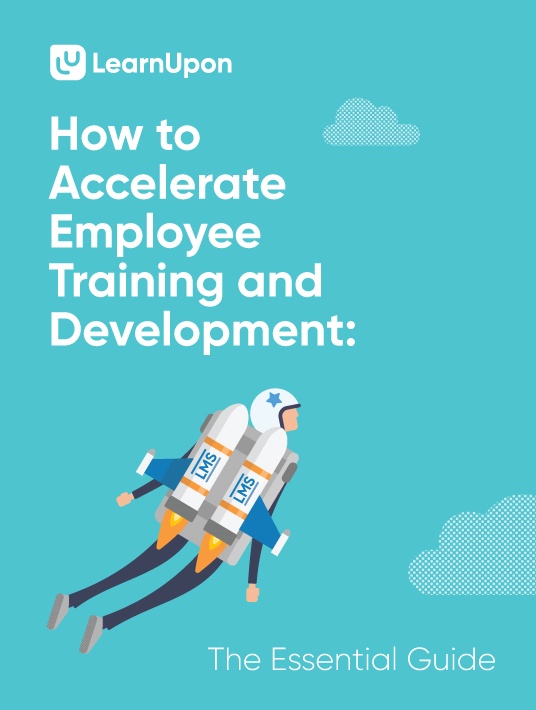Plan Your Employee Training Program
Setting up a corporate learning program isn't exactly rocket science. But a well-defined employee training program doesn’t happen overnight. Being proactive and creating a well-planned strategy makes it that little more simple, streamlined, and importantly, achievable. To enable you to set up a workable employee training program, where you know your goals and have the tools you need to reach them, we’ve created this list to help you. We’ve outlined 6 key steps that will help you to incrementally develop a strategy that works for you.

1. Analyze Your Training Needs
Right now your business is doing some form of employee training and development whether you're aware of it or not. It's either formal - face-to-face training or eLearning - or it's informal - sporadic, casual education between co-workers. Before you jump in and start planning or adding to it, it's vital you investigate what, when, and where it's all happening. Many businesses skip this step and it causes them to miss the mark down the line as they haven't taken the time to discover what training is really needed for the organization. But, when you do a full assessment of your current training strategy, you’ll have a much clearer idea of your learning goals. So, what does your analysis entail? For your research, you should get into the weeds of what's really going on within your organization. Get as granular as possible and ask:
- What tools/resources/training materials are currently being distributed to our workforce?
When someone joins your organization do they receive an onboarding pack? Or are they left to their own devices? When a new tool is introduced, how are your employees trained? Do you use a learning management system? Find every guide, book, course, etc. that’s given to your staff.
- What are individual teams' training practices?
Approach every team and ask what they are doing that is specific to them. Ask what software they use, how they learn soft-skills, and how they onboard new team members. This way you’ll get a good overview of what matters to specific teams.
- What common skills gaps do managers see within their teams?
Next, go straight to the managers and senior stakeholders in your organization. Query them on what training they believe their employees need and what they think helps and hinders the learning process.
- What training are employees finding helpful and what training is absent? Depending on the size of your organization, you can do this by individual, team or via survey. Whatever the method, it’s important to get your employee’s honest opinions on how they rate their current training and what they would like to see in the future.
2. Create A Plan To Fill The Training Gaps
Through your analysis, you'll begin to identify the training gaps within your organization. You'll see where your employees are succeeding and where you need to plug a leaky training bucket. Now is the time to plan how you will fill these gaps. Odds are you'll uncover tons of learning opportunities. However, depending on your resources, you can't create courses for every single one from the get-go. You need to prioritize. To do this, list all the training that's required or wanted within your organization. Then, rank what's most important. It's up to you to decide what's most pressing. If you notice a pattern of poor onboarding, focus on this. Or if you need to deliver company-wide compliance training, it's a no-brainer this should be priority number one. It completely depends on your organization and your desired goals. Your training plan should also focus on how you plan on delivering training. Do you plan on using an LMS solely or using a blended learning model? How are you going to assess your learners? What tools do you need to deliver training? The more you get into the nitty-gritty details and answer these questions, the easier the process will be in the long run.
3. Invest In The Tools And Resources You Need
A major step in your training strategy is investing in the right tools that enable you to deliver impactful training. Most important is an LMS that will manage, deliver, and track your employee training and development. From your above analysis and planning, you should be able to develop a good outline of what you’d like from your LMS to begin your search. Additionally, you should decide if you need to invest in other tools and resources such as:
- Content creation tools e.g. authoring tools, webinar software, video software, etc.
- Project management tools
- Instructors and designers to help create content
Remember, you don’t have to invest in every tool from the offset. We suggest prioritizing your immediate needs and then building a toolkit as you progress. This ensures you’re only using the tools you really need and getting the most value from each one.
4. Develop Your Course Content
A frequent mistake businesses make is underestimating the time and effort it takes to create course content. Training courses take some preparation to get them developed as there are lots of spinning plates. To get started, rummage through the content you already have. You’d be surprised how many materials within your organization can be repurposed into course content. From face-to-face training presentations and handouts to individual team guides, building eLearning courses with materials you already have is a great way to get a head start. Additionally, look to outside avenues. YouTube videos, podcasts, industry reports, etc; these can all be added to your training content. If you’re starting from scratch, a top tip is to go to the subject experts within your organization. Collaborate with them and get their advice on the best way to train on a subject, how to assess your learners, how to structure the course, and so on. This will make the content creation process simpler to achieve.
5. Implement Your Training
LMS in hand, training material done, you can finally implement your training program. To ensure it has the greatest chance of success there are some guidelines you should follow. Firstly, it’s tempting to enroll all your learners in a course all at once, but this isn’t the best plan of action. Instead, roll your training out slowly. Add a couple of courses to your LMS and enroll a small sample of your employees to take them. This sample group will be your guinea pigs and if anything goes wrong, you can work out the kinks before the greater organization is added. The same goes for your LMS features. Start simply, then slowly implement more sophisticated workflows. That way you’ll see how your users truly react to the LMS and your content. Then, after a while, you can explore more advanced features like gamification, forums, and more.
6. Continuously Measure And Adapt
The real secret to developing a successful employee training and development strategy is investing time to always improve it. Using LMS features like reports and user surveys will show you where your training is succeeding and areas of refinement. Based on this feedback, if you continuously adapt, tweak, and optimize your training programs, it will put your business on the path to success. Download the eBook How to Accelerate Employee Training and Development to delve deeper into Vital LMS Integrations for Employee Training and Development as well as many other useful insights.
If you want to discover more fantastic features you need to implement to guarantee the best possible employee training, check out the Make Your Employee Training Robust And Engaging: How To Get The Perfect Balance Webinar. It is brought to you by LearnUpon and teaches everything you need to know to make your employee training exceptional.










